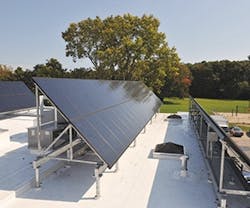If you want to harness the power of sunlight, there are several key considerations to address before giving a project the green light. The benefits of PV are well-known, but there are lesser-known hurdles to clear before seizing them.
“The big, immediate questions are how much space is on the roof, how much sun the rooftop gets, and what the cost of electricity is,” explains James R. Kirby, vice president of sustainability for the Center for Environmental Innovation in Roofing, a not-for-profit 501(c)(6) organization.
Once you’ve addressed those fundamental interests and decided PV is a worthwhile project, there are still three primary concerns. Be familiar with the following items to streamline a long-lasting installation.
1) Roof Construction
“PV systems can go over the top of any membrane,” says Joan P. Crowe, director of technical services for the National Roofing Contractors Association. “The biggest factor is if the roof can structurally handle the extra load.”
There is conflicting research whether certain membranes integrate with PV better than others, Kirby notes.
“PVs are more efficient when they’re cool. If they’re raised off the roof surface to allow air flow, that helps dissipate heat,” he adds. “The ambient temperature has a bigger impact than the roof surface temperature. As long as it is shaded, the material underneath doesn’t really matter.”
Enlisting a structural engineer is necessary for an existing roof. Thin-film laminates weigh as little as 1-1.5 pounds per square foot, whereas rack systems range from 3-6 pounds, Kirby explains.
“The structural engineer needs to know how the load is spread across the roof because from a wind loading standpoint, the corners and edges are more critical than the center of the array,” he adds.
Whether PV racks rest on ballasts or penetrate the roof likely depends on wind load, explains Mark Stancroff, director of solar roofing for manufacturer CertainTeed.
“On the Gulf Coast or in high wind areas, there is some preference for penetrations because they’re sturdier,” he notes. “Otherwise, ballasts are the most common.”
There are several viable options depending on your specific situation.
“If there was one best way, everyone would be doing it, but every scenario is different,” Kirby says. “Over the next 10 years, I think we might end up with a hybrid of penetrations where the attachment needs to be solid with ballasts everywhere else.”
2) Roof Service Life
It is important to evaluate whether the remaining usable life of your roof coincides with the PV system’s life expectancy because re-roofing with PV in place is difficult and cost-prohibitive, cautions Crowe.
“There’s no magic number for when a roof should be replaced, but the efficiency of PV systems lasts 25 years,” Kirby says. “Sometimes it makes sense to replace or upgrade the roof before adding PV.”
In some cases, a PV installation can void the warranty of your existing roof system, warns Gary Thompson, general manager of innovative products and services for manufacturer Firestone Building Products.
“When non-roofing trades work on roofs, they can tear them up,” Thompson explains. “We get tons of calls from owners saying that they’ve already installed a PV system and want to make sure the warranty is still intact.”
These situations are financial time bombs that can blow your payback to smithereens, Thompson adds. Firestone offers roof warranties from 5-30 years, for example, so be sure to involve your roofing provider preemptively.
3) Local Incentives
The federal government offers a 30% investment tax credit on solar projects through 2016. However, that incentive alone is rarely enough to spur a project.
“The economics of solar vary greatly by state,” explains Stancroff. “If you’re not in a state or city that provides very attractive incentives, there’s very little economic sense in moving forward.”
Areas that offer the best opportunities include California, Colorado, Texas, and states in the mid-Atlantic and Northeast regions, adds Kirby.
“Some of those are starting to go away as the price of PVs decreases, but there are also renewable energy credits and power purchasing agreements to factor in,” he stresses.
A list of all available state and local incentives – including loans, tax credits, and utility participation – can be found at www.dsireusa.org.
The most ideal installations will generate a payback of four to six years, Kirby says. “Most building owners want something in that five-year range. It can be up to 20 in some areas, which only makes sense for universities or long-term owners,” he adds.
Do your due diligence and you should find a solution that provides long-term service life for both the roof and PV systems.
“If your combined systems last 25 years and the PV array pays for itself in five, then you’re just printing money for the next two decades,” Thompson says.
Chris Curtland [email protected] is assistant editor of BUILDINGS.
